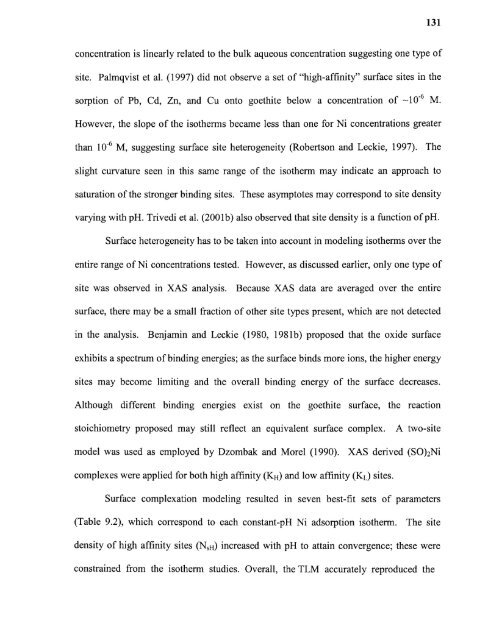Heavy metal adsorption on iron oxide and iron oxide-coated silica ...
Heavy metal adsorption on iron oxide and iron oxide-coated silica ...
Heavy metal adsorption on iron oxide and iron oxide-coated silica ...
Create successful ePaper yourself
Turn your PDF publications into a flip-book with our unique Google optimized e-Paper software.
131c<strong>on</strong>centrati<strong>on</strong> is linearly related to the bulk aqueous c<strong>on</strong>centrati<strong>on</strong> suggesting <strong>on</strong>e type ofsite. Palmqvist et al. (1997) did not observe a set of "high-affinity" surface sites in thesorpti<strong>on</strong> of Pb, Cd, Zn, <strong>and</strong> Cu <strong>on</strong>to goethite below a c<strong>on</strong>centrati<strong>on</strong> of —10-6 M.However, the slope of the isotherms became less than <strong>on</strong>e for Ni c<strong>on</strong>centrati<strong>on</strong>s greaterthan 10-6 M, suggesting surface site heterogeneity (Roberts<strong>on</strong> <strong>and</strong> Leckie, 1997). Theslight curvature seen in this same range of the isotherm may indicate an approach tosaturati<strong>on</strong> of the str<strong>on</strong>ger binding sites. These asymptotes may corresp<strong>on</strong>d to site densityvarying with pH. Trivedi et al. (2001b) also observed that site density is a functi<strong>on</strong> of pH.Surface heterogeneity has to be taken into account in modeling isotherms over theentire range of Ni c<strong>on</strong>centrati<strong>on</strong>s tested. However, as discussed earlier, <strong>on</strong>ly <strong>on</strong>e type ofsite was observed in XAS analysis. Because XAS data are averaged over the entiresurface, there may be a small fracti<strong>on</strong> of other site types present, which are not detectedin the analysis. Benjamin <strong>and</strong> Leckie (1980, 1981b) proposed that the <strong>oxide</strong> surfaceexhibits a spectrum of binding energies; as the surface binds more i<strong>on</strong>s, the higher energysites may become limiting <strong>and</strong> the overall binding energy of the surface decreases.Although different binding energies exist <strong>on</strong> the goethite surface, the reacti<strong>on</strong>stoichiometry proposed may still reflect an equivalent surface complex. A two-sitemodel was used as employed by Dzombak <strong>and</strong> Morel (1990). XAS derived (SO)2Nicomplexes were applied for both high affinity (KH) <strong>and</strong> low affinity (KO sites.Surface complexati<strong>on</strong> modeling resulted in seven best-fit sets of parameters(Table 9.2), which corresp<strong>on</strong>d to each c<strong>on</strong>stant-pH Ni <str<strong>on</strong>g>adsorpti<strong>on</strong></str<strong>on</strong>g> isotherm. The sitedensity of high affinity sites (NSH) increased with pH to attain c<strong>on</strong>vergence; these werec<strong>on</strong>strained from the isotherm studies. Overall, the TLM accurately reproduced the
















